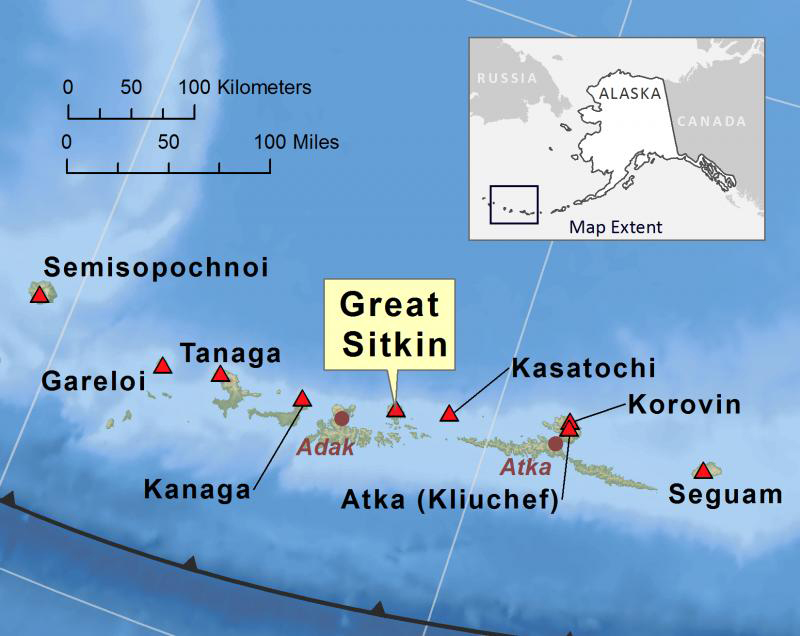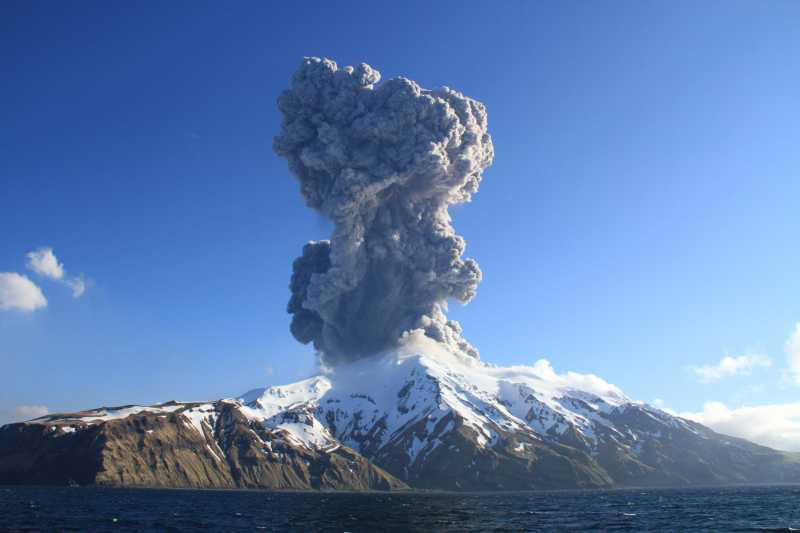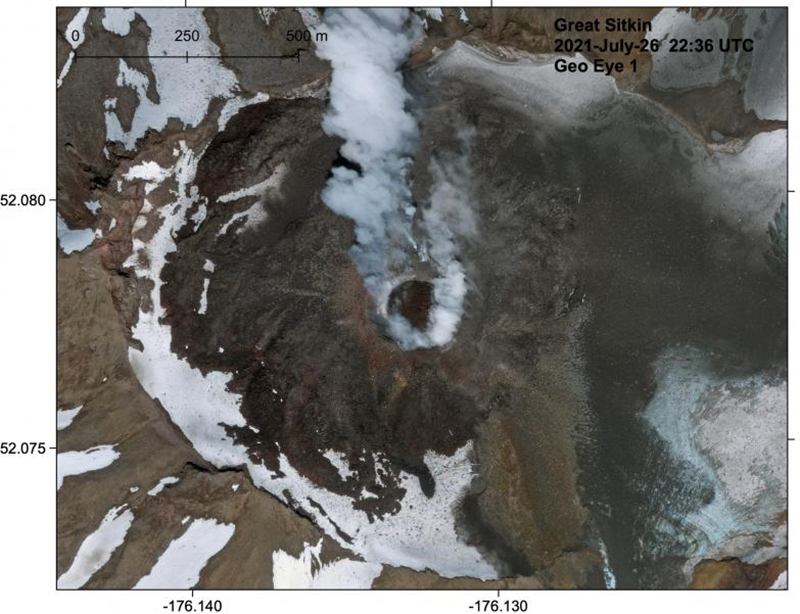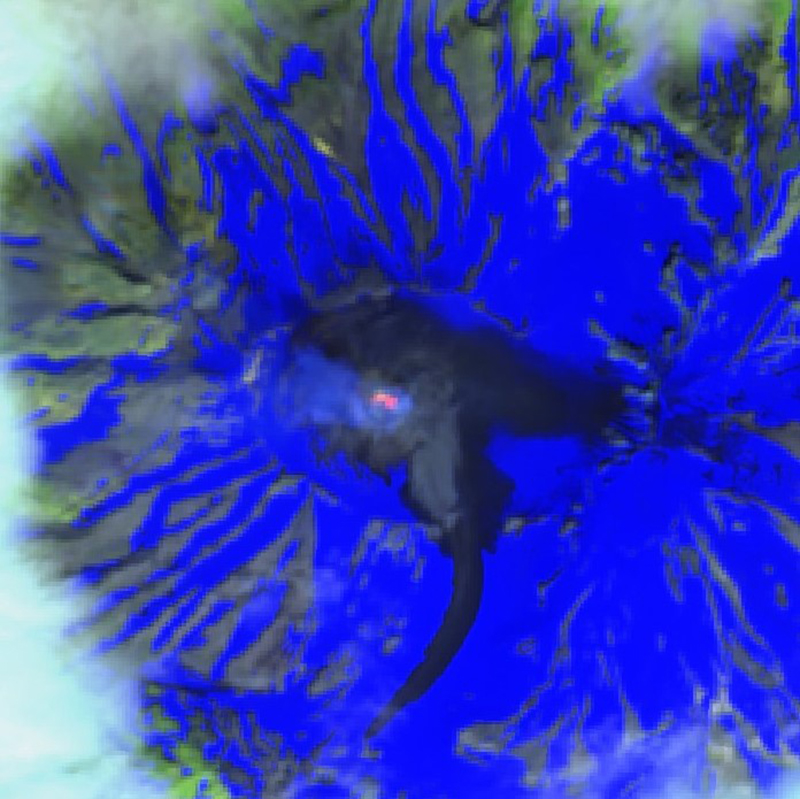Report on Great Sitkin (United States) — August 2021
Bulletin of the Global Volcanism Network, vol. 46, no. 8 (August 2021)
Managing Editor: Edward Venzke.
Research and preparation by Paul Berger.
Great Sitkin (United States) Explosion on 25 May 2021 and new summit crater lava dome in July 2021
Please cite this report as:
Global Volcanism Program, 2021. Report on Great Sitkin (United States) (Venzke, E., ed.). Bulletin of the Global Volcanism Network, 46:8. Smithsonian Institution. https://doi.org/10.5479/si.GVP.BGVN202108-311120
Great Sitkin
United States
52.076°N, 176.13°W; summit elev. 1740 m
All times are local (unless otherwise noted)
No major eruption has occurred at Great Sitkin since 1974, but intermittent steam emissions and small steam explosions, accompanied by slightly elevated seismicity, were observed during July 2016-December 2017, and most recently during June-December 2018 and in June 2019 (BGVN 43:09, 44:07). The volcano, located in the Aleutian Islands (figure 9) is monitored by the Alaska Volcano Observatory (AVO) using local real-time seismic and infrasound sensors, satellite data, web cameras, and remote infrasound and lightning networks. Events from July 2019 through July 2021 are summarized in this report.
 |
Figure 9. Location map showing Great Sitkin and other nearby volcanoes in the Aleutian Islands. Courtesy of AVO. |
On 15 July 2019, AVO reported that the seismicity recorded in June 2019 had decreased to background levels over the previous few weeks, with no evidence of eruptive activity in geophysical or satellite data. The Aviation Color Code (ACC) was lowered to Green and the Volcano Alert Level (VAL) was lowered to Normal. On 26 February 2020 AVO noted that seismicity had increased during the previous month, but by 21 October it had returned to background levels and no eruptive activity or unusual surface temperatures had been observed in satellite images. A Volcano Observatory Notice for Aviation on 13 May 2021 noted that elevated surface temperatures identified by AVO in satellite images since January had increased in frequency during the previous two months. A minor increase in seismicity began on 9 May and volcanic gas emissions increased on 10 May.
An increase in local earthquakes during 24-25 May prompted AVO to raise the ACC to Orange and the VAL to Watch. An explosive eruption began on 25 May at 2104; the ACC and the VAL were raised to Red/Warning, respectively. The explosions lasted for 1-2 minutes and produced an ash plume that rose to an altitude of 4.6 km (figures 10 and 11). Witnesses 42 km away heard “a very loud explosion.” After the explosive period, seismicity decreased and satellite image images showed a detached plume drifting E. Around mid-morning on 26 May, AVO lowered the ACC and VAL to Orange/Watch, respectively.
 |
Figure 10. Eruption plume of Great Sitkin on 25 May 2021 at 2106 (local time) as seen from the RV Tiglax. Courtesy of Lauren Flynn (U.S. Fish and Wildlife Service). |
Seismicity was low on 27 May 2021 and satellite images showed only minor steaming along with slightly elevated surface temperatures. Seismicity remained low through 1 June; moderately elevated surface temperatures were detected during 29-30 May. Aerial images on 30 May and 6 June showed ash deposits from the 25 May explosion (figure 11).
According to AVO, a satellite image acquired at 0932 on 22 July 2021 showed a small area of uplift, about 50 m in diameter, and elevated surface temperatures associated with this feature. A Sentinel-2 satellite image suggested that the elevated surface temperature had begun on 12 July or earlier (figure 12). A 26 July satellite image confirmed that the feature was a lava dome that it had grown to 130 m in diameter (figure 13). Seismic data suggested that the dome probably emerged sometime during 14-22 July. Unrest continued during 26-31 July, with small earthquakes but no explosive activity. Elevated surface temperatures were detected on 27 and 28 July, and on 28 July a steam plume was observed drifting N in satellite imagery.
 |
Figure 13. GeoEye-1 satellite image of Great Sitkin showing the new circular lava dome in the summit crater on 26 July 2021. Courtesy of AVO. |
Geological Summary. The Great Sitkin volcano forms much of the northern side of Great Sitkin Island. A younger volcano capped by a small, 0.8 x 1.2 km ice-filled summit caldera was constructed within a large late-Pleistocene or early Holocene scarp formed by massive edifice failure that truncated an older edifice and produced a submarine debris avalanche. Deposits from this and an even older debris avalanche from a source to the south cover a broad area of the ocean floor north of the volcano. The summit lies along the eastern rim of the younger collapse scarp. Deposits from an earlier caldera-forming eruption of unknown age cover the flanks of the island to a depth up to 6 m. The small younger caldera was partially filled by lava domes emplaced in 1945 and 1974, and five small older flank lava domes, two of which lie on the coastline, were constructed along northwest- and NNW-trending lines. Hot springs, mud pots, and fumaroles occur near the head of Big Fox Creek, south of the volcano. Eruptions have been recorded since the late-19th century.
Information Contacts: Alaska Volcano Observatory (AVO), a cooperative program of a) U.S. Geological Survey, 4200 University Drive, Anchorage, AK 99508-4667 USA (URL: https://avo.alaska.edu/), b) Geophysical Institute, University of Alaska, PO Box 757320, Fairbanks, AK 99775-7320, USA, and c) Alaska Division of Geological & Geophysical Surveys, 794 University Ave., Suite 200, Fairbanks, AK 99709, USA (URL: http://dggs.alaska.gov/); Sentinel Hub Playground (URL: https://www.sentinel-hub.com/explore/sentinel-playground).



